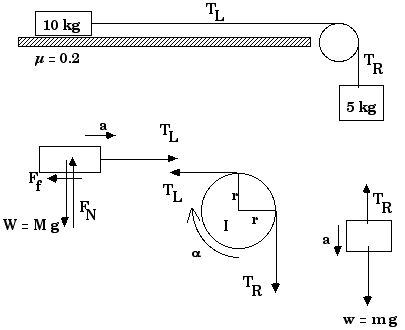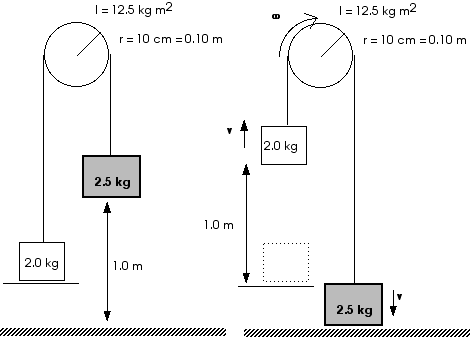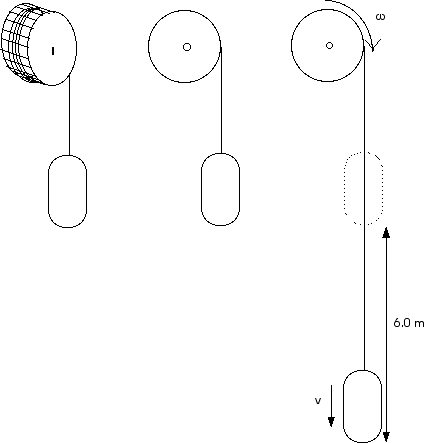
Chapter 10; Rotational Kinematics and Energy
![]()
| ToC, Chapter 10 | Course Calendar |
![]()

Chapter 10; Rotational Kinematics and Energy
![]()
| ToC, Chapter 10 | Course Calendar |
![]()
D10.1 It requires 6 seconds for a phonograph
turntable initially rotating at 33 rpm to reach 45 rpm. Assume the angular acceleration
is uniform. How many revolutions are made during this time?
![]() =
= ![]() i
+
i
+ ![]() i
t +
i
t + ![]()
![]() t2
t2
![]() = 0 + (3.46
= 0 + (3.46 ![]() )
(6 s) +
)
(6 s) + ![]() (0.208
(0.208 ![]() )
(6 s)2
)
(6 s)2
![]() = 20.76 radians + 3.75 radians = 24.51 radians
= 20.76 radians + 3.75 radians = 24.51 radians
![]() = 24.51 radians (
= 24.51 radians ( ![]() ) = 3.90 revolutions
) = 3.90 revolutions
D10.2 A ventilator fan is turning at 600 rpm when the power is cut off and it turns through 1000 revolutions while coasting to a stop. Find the angular acceleration and the time required to stop.
![]() i
= 600
i
= 600 ![]()
![]()
![]() = 62.8
= 62.8 ![]()
wf = 0
( ![]() f
-
f
- ![]() i
) = 1000 rev
i
) = 1000 rev ![]() = 6 280 rad
= 6 280 rad
![]() 2
=
2
= ![]() i2
+ 2
i2
+ 2 ![]() (
( ![]() f
-
f
- ![]() i
)
i
)
(0)2 = (62.8 ![]() )2
+ 2
)2
+ 2 ![]() (6 280 rad)
(6 280 rad)
(0)2 = 3 948 ![]() + (12 560 rad)
+ (12 560 rad) ![]()
(12 560 rad) ![]() = - 3 948
= - 3 948 ![]()
![]() = - 0.31
= - 0.31 ![]()
![]() =
= ![]() i
+
i
+ ![]() t
t
0 = 62.8 ![]() + (- 0.31
+ (- 0.31 ![]() ) t
) t
(0.31 ![]() ) t = 62.8
) t = 62.8 ![]()
t = 203 s
D10.3 A solid, uniform cylinder of 12 cm radius with mass of 5.0 kg is free to rotate about its symmetry axis. A cord is wound around the drum and a 1.2 kg mass is attached to the end of the cord. Find the acceleration of the hanging mass, the angular acceleration of the cylinder, and the tension in the cord.

For the 1.2 kg mass, take down as positive and apply Newton's Second Law,
For the rotating cylinder, apply the rotational form of Newton's Second Law,
since ![]() = 90°
= 90°
For a solid cylinder,
Therefore,
At the moment, we have three unknowns,
T, a, and ![]() ,
in two equations. The angular acceleration of the cylinder and the linear
acceleration of the cord or of the hanging mass are connected by
,
in two equations. The angular acceleration of the cylinder and the linear
acceleration of the cord or of the hanging mass are connected by
Now we have two equations in two unknowns
T = 8.1 N
D10.4 A 10 kg block sits on a horizontal
surface with coefficient of friction of 0.2 between the block and the surface.
A string runs from this block over a wheel of radius 10 cm and moment of inertia
of 2.0 kg m2 and is attached to a hanging 5 kg mass. Find the acceleration
of the masses, the angular acceleration of the wheel, and the tension in the
string on each side.

Notice that the tension is different on
the two sides of the pulley because the pulley is (very) massive.
For the 10-kg block on the horizontal plane, we can
write
and
FN = 100 N
We can use this information to determine the friction force,
Then the Fnet,x equation becomes
For the massive pulley, we have
We now have four unknowns -- TL,
TR, a, and ![]() -- in two equations. The angular acceleration of the cylinder and the
linear acceleration of the cord or of the hanging mass are connected by
-- in two equations. The angular acceleration of the cylinder and the
linear acceleration of the cord or of the hanging mass are connected by
TR - TL = (200 kg) a
We now have three unknowns --TL, TR, and a -- in two equations. We still must apply Newton's Second Law to the hanging mass. There we may as well take down as positive,
Now we have three equations for three unknowns,
TR = 20 N + (190 kg) (0.15
![]() )
= 49.2 N
)
= 49.2 N
D10.5 Assume a playground merry-go-round to be a uniform cylinder or disk of 150 kg and 1.8 m radius. What is its moment of inertia?
It is initially at rest when a 50 kg child, running at 4 m/s, in a direction tangential to the edge of the merry-go- round, jumps on. What is its angular velocity after the child sits down on the edge?
For a solid disk or cylinder,
Therefore, the moment of inertia of the merry-go-round is
The initial angular momentum of the child is
The initial angular momentum of
the merry-go-round is zero.
So the total initial angular momentum of the entire system
is
If the bearings of the merry-go-round are well oiled this should be the total final angular momentum,
but now the moment of inertia is the moment of inertia of the merry-go-round and the child
D10.6 What is the kinetic energy of tire with moment of inertia of 60 kg m2 that rotates at 150 rpm?
D10.7 A disk rolls without slipping
down a hill of height 10.0 m. If the disk starts from rest at the top of the
hill, what is its speed at the bottom?
Initially, the disk has gravitational potential energy
At the bottom all of this energy has become kinetic energy-but we have both kinetic energy of translation and kinetic energy of rotation,
If, as we assume, the disk rolls without slipping, then
or
Notice that we are not given the radius or the mass of the disk. This may be somewhat disconcerting, but we will continue anyway and expect that these will "disappear" in the end.
Therefore,
D10.8 An Atwood's machine is composed of a 2-kg mass and a 2.5-kg mass attahed to a string hanging over a wheel that has a radius of 10 cm and a moment of inertia of 12.5 kg-m2. The 2.5-kg mass is initially 1.0 m above the floor. Use conservation of energy to find the speed of this mass just before it hits the floor.

Initially,
Finally (just before the 2.5 kg block hits the floor),
D10.9 A basket of tomatoes of mass 20.0 kg is being hoisted by a windlass. The rope is wrapped around an axle that is a solid cylinder of wood having a radius of 0.1 m and a mass of 10 kg. The mass of the crank handles is neglibible. The operator lets go of the handle when the basket is 6 m above the ground. With what linear speed does the basket strike the ground?
The moment of inertia for a solid cylinder (or a disk) is
The velocity of the load and the angular velocity of the windlass are connected by
As always, good diagrams make life much simpler.

Initially, before the windlass and load are released, we have
In this problem, as in the
previous one, the Kinetic Energy of the wheel or drum
or cylinder is far greater than the Kinetic Energy of the
masses and dominates the entire motion.
Finally, after the windlass has increased its angular speed and the
load has increased its linear speed, and just before the load hits
the floor, we have
D10.10 To demonstrate conservation of angular momentum a Physics professor stands on a frictionless turntable with a 2 kg mass in each outstretched hand. An assistant gives her a small initial angular velocity of 2 rad/s. She then drops her hands to her sides and her angular velocity increases dramatically. As a rough estimate, consider her arms to have mass of 5 kg each and to be 1 m long rods hinged at the axis of rotation. The rest of her body has an approximate moment of inertia of 0.55 kg m2. Find her final angular velocity when the masses are 0.25 m from the axis of rotation. Calculate the initial and final values of the rotational kinetic energy and explain the cause of the difference in these values.
The initial angular momentum is
(It is only a coincident
that L and KE happen to have the same numerical value!).
As she pulls in her hands, the total moment of inertia
changes,
Total angular momentum is conserved,
Work must be done on the
weights to pull them in toward the axis of rotation. This work
that is done by the dizzy professor shows up as increased kinetic
energy.
![]()
(c) 2005, Doug Davis; all rights reserved .